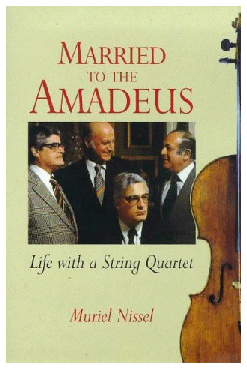|
Married to the Amadeus
Life with a String Quartet

Muriel Nissel
Married to the Amadeus:
Life with a String Quartet
(ISBN 9781900357128
eISBN 9781900357388)
was published as a paperback original in August 1998
216 pages 234 x 156 mm 50 black & white illustrations
£12.99
Classical Music: '...a thoroughly absorbing, well-written account of the Amadeus Quartet story observed from the inside.'
Description
The Amadeus Quartet, which was active from 1948 until 1987 when its viola player Peter Schidlof died, is probably the most famous and distinguished string quartet of the 20th century. It played to a wide variety of audiences on innumerable occasions in all the major countries of the world, and produced a galaxy of recordings, many of which are still available. The intensity of its music-making was breathtaking.
<> Muriel Nissel, the author of Married to the Amadeus, is the wife of Siegmund Nissel, the second violinist. Her book tells the extraordinary and moving story of the Quartet, with its many triumphs and its periodic setbacks and traumas, from the inside for the forty years from its inception during the time after the Second World War up to the 1980s. She reveals how it moulded the lives of the four players and their wives and families in unexpected ways, and how they all became inextricably involved in this unique joint enterprise. The fashion in which work and family life interacted was crucial to the Quartet's survival.
<> She returned to her professional life as a statistician when the children went to school and describes how difficult it was in the 1960s for a married woman with children to achieve equal status with men at work; and she tells of the problems she also had to face at home finding satisfactory ways of caring for her family
Remarkably, the four members of the Quartet remained unchanged throughout. They each of them had exceptional qualities. Norbert Brainin, the first violin, Siegmund Nissel and Peter Schidlof, all refugees from Vienna, had first met in internment camps in Britain in 1940. Martin Lovett, the cellist, joined them not long after the war, at a moment when the musical climate was sympathetic to chamber music and the record industry was booming. They never looked back.
<> Nobody who has read Muriel Nissel's absorbing book will ever be able to listen to a string quartet again without being aware of the immense commitment such a group demands of the players and of their families too, and of the longstanding emotional, aesthetic and organizational complexities it entails.
Author
After graduating from Oxford University with a degree in Philosophy, Politics and Economics, Muriel Nissel worked in the Civil Service until she married Siegmund Nissel in 1957. In the early years when she was at home looking after their two young children, she carried out research into the economics of the arts for a study based at Princeton University in the States. She was also appointed a magistrate. When the children went to school, she joined the Central Statistical Office and was the first editor of Social Trends, a highly successful annual government publication, now in its 28th year. She left the Civil Service in 1976 and in the following year joined the Policy Studies Institute, researching mainly into the family and the arts. She was a member of the Gulbenkian Enquiry into the Training of Musicians, which reported in 1977. She is now retired but still works on a freelance basis.
|